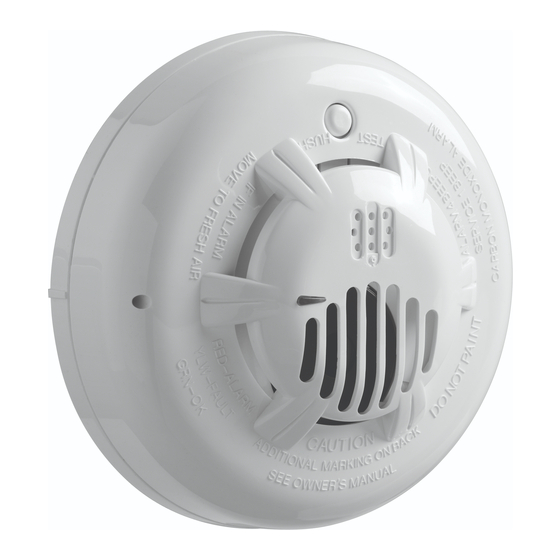DSC PG9933 Installatie- en bedieningsinstructies voor de installateur - Pagina 6
Blader online of download pdf Installatie- en bedieningsinstructies voor de installateur voor {categorie_naam} DSC PG9933. DSC PG9933 9 pagina's. 915mhz wireless carbon monoxide detector

2. Immediately move to fresh air - outdoors or by opening door/window. Do a head
count to check that all persons are accounted for. Do not reenter the premises nor
move away from the open door/window until the emergency services responders
have arrived, the premises have been aired out, and your alarm remains in nor-
mal condition.
3. After following steps 1 - 3, if your alarm reactivates within a 24-hour period,
repeat steps 1 - 3 and call a qualified technician (Tel. No. ........................) to
investigate for sources of CO gas from fuel burning equipment and appliances,
and inspect for proper operation of this equipment. If problems are identified dur-
ing this inspection, have the equipment serviced immediately. Note any com-
bustion equipment not inspected by the technician and consult the manufacturer
instructions, or contact the manufacturers directly, for more information about
CO safety and this equipment. Make sure that motor vehicles are not, and have
not been, operating in an attached garage or adjacent to the residence.
WARNING: CO gas can be extremely fatal and can come from several possible
sources. This detector only indicates the presence of CO gas near the sensor. CO
gas may be present in other areas of the premises.
Action to be Taken After the Problem has been Corrected
Once the CO gas presence in the premises has been corrected, the detector's alarm
should be off. After waiting for 10 minutes, push the Test/Hush button to verify that
the detector is functioning properly.
Warnings and Limitations
This product is intended for use in ordinary indoor locations of family living units. It is
not designed to measure compliance with Occupational Safety and Health Admin-
istration (OSHA) commercial or industrial standards.
CAUTION: The detector will only indicate the presence of carbon monoxide gas at
the sensor. Carbon monoxide gas may be present in other areas.
Individuals with medical problems may consider using warning devices that provide
l
audible and visual signals for carbon monoxide concentrations under 30 ppm.
The alarm, including the sensor, is not to be located within 1.5m (5 feet) of any
l
cooking appliance.
The detector may not emit an alarm at low carbon monoxide levels. The Occu-
l
pational Safety and Health Association (OSHA) has established that continuous
exposure levels of 50 ppm should not be exceeded in an 8 hour period. Individuals
with medical conditions may consider more sensitive detection devices.
The CO gas detector is not suitable as a smoke detector or fire detector. This
l
detector is not suitable to install in hazardous locations as defined in the National
Electrical Code.
Carbon monoxide must reach the detector for proper performance of CO gas detec-
l
tion. The detector may not protect people who are at special risk from carbon
monoxide exposure by reason of age, pregnancy or medical condition. If in doubt,
consult your medical practitioner.
CO detectors may wear out because they contain electronic parts that fail over
l
time. Test your detector at least every week.
Instruct children never to play with the detector.
l
Never use detergents or other solvents to clean the detector.
l
Avoid spraying air fresheners, hair spray, paint or other aerosols near the detector.
l
Do not paint the detector. Paint will seal the detectors vents and interfere with
l
detecting CO gas.
Detailed information on conditions which can result in transient
CO situations:
1. Excessive spillage or reverse venting of fuel burning appliances caused by:
a. Outdoor ambient conditions such as wind direction and/or velocity, includ-
ing high gusts of wind; heavy air in the vent pipes (cold/humid air with
extended periods between cycles).
b. Negative pressure differential resulting from the use of exhaust fans.
c. Simultaneous operation of several fuel burning appliances competing for
limited internal air.
d. Vent pipe connection vibrating loose from clothes dryers, furnaces, or
water heaters.
e. Obstructions in or unconventional vent pipe designs which amplify the
above situations.
2. Extended operation of unvented fuel burning devices (range, oven, fireplace,
etc.).
3. Temperature inversions which can trap exhaust gases near the ground.
4. Car idling in an open or closed attached garage, or near a home.
Never disassemble the CO Alarm; there are no user serviceable parts inside the unit.
You may only remove the CO Alarm from the mounting bracket to replace the battery
if not serviced by an installer. When replacing the battery, follow the directions spe-
cified within the Installation Instructions, Installing/Replacing battery.
CAUTION: This product uses a lithium battery. Improper handling may result
in HEAT, EXPLOSION or FIRE causing personal injury. DO NOT recharge
